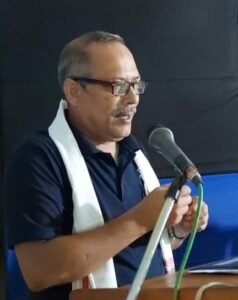Silver Jubilee carnival for Kaliabor Press Club
Guwahati,Rongili Barta- That was an amazing experience to attend the foundation day of a 25 years old press club in central Assam on a lazy Sunday, where a number of senior citizens along with rural scribes and novice journalists were waiting to listen to my speech. It’s easier to address a journalist’s meet- where we can discuss many issues with liberties, but while the audience include respected senior citizens and young people, it becomes a difficult task to speak to them together. First, the question that arises, how much should I highlight the eroding credibility for the mainstream media around India in general and Assam in particular and secondly what may be the role of social (alternate/digital) in reshaping the newspapers and satellite news channels! Thirdly, I must discuss the abundant opportunities brought out by the internet services, which has almost redesigned the present socio-cultural, political and economical landscape around the world. As I got down from the long-drive bus at a point near to Jakhalabandha stoppage, it was Jayanta Kumar Sarma who came to escort me for the function. Jayanta, secretary of Kaliabor Press Club, gave me the initial briefing about the organization and the function. Soon Nayan Saikia, a Guwahati-based senior journalist- who continues to be a supportive hand to the local press club, welcomed me for the program. Before the meeting began, we had some time for lunch, which was simple but tasty. After a few formalities, including a welcome chorus by some local girls who performed a spirited song of Dr Bhupen Hazarika, the chair asked me to address the gathering. Prior to it, the organizers greeted me (along with Nabin Borthakur- associated with Asom Sahitya Sabha and Pranab Mahanta, a media enthusiast on the dais) in traditional ways and the press club president Tapan Saikia introduced me to the audience. Some of the distinguished listeners (Hemadhar Hazarika, Bhupen Sarma, Dhruba Borgohain, Puspendra Saikia, Pulak Bora, Ajit Bhagawati, Jayanta Kr Khound, Bipul Hazarika, Achyut Saikia, Krishna Mahanta, etc) were even known to me. I tried to analyze the crisis faced by the mainstream media outlets with the advent of an aggressive social media. The shrinking space for newspapers was multiplied during the Covid-19 pandemic induced national lock down, as rumours spread that the physical paper would carry the coronavirus. Slowly the readers turned to alternate media (precisely the news portals) and many of them did not return to their age-old habit of reading a newspaper in the morning hours. Once a sizable number of committed readers go away, the newspapers have lost their influence on them for good. Across India, we should have over 50 crore mobile phone (connected with internet) users and many of them continue to read newspapers. The problem began, when the readers started questioning the contents of newspapers columns as often old, one-sided and non-comprehensive. The issue did not end here, as many internet users began to criticize the newspaper (also satellite news channel) contents in digital media space. Some of them even went on criticizing the editors with personal attacks. So gradually the editor-journalists have found themselves in an awkward position while facing the public. Hence it’s the time for the mainstream media persons to be more cautious, authentic and credible to the readers, listeners and viewers. Perhaps, we have arrived in a period where we can no longer generate news items according to our convenience. If we keep our accountability aside, the social media users (some of them may be retired working journalists) will remind us of it. The reminders may be polite in nature or even aggressive (and we will have no other option than acknowledging it). Finally, I insisted that journalists may continue to be popular, inspiring and influential, if we can maintain our credibility and be honest to the respective audience. The so-called glamour, wealth and political affiliation would be useless in the days to come. A challenging time for professional journalists has welcomed all of us and we must survive with our truthfulness, dedication and commitment to the medium, our society and the nation. For records, Kaliabor Press Club was formed by some struggling rural scribes on 17 July 1997 and the present set of members (not more than 50) are celebrating their silver jubilee year. State minister Keshab Mahanta, hailing from the locality, launched the year long celebration at its premises on 16 January last in presence of distinguished personalities including performing artiste Jina Rajkumari. The press club members organized the foundation day program on 16 and 17 July. A journalist workshop (in memory of two pioneer journalists from Kaliabor namely Govindaram Bhuyan and Abhiram Bhuyan) was also organized at Jakhalabandha HS School auditorium where Asom Bani editor Dileep Chandan and NKTV news reporter Biswajyoti Sarma were present as resource persons. It was followed by a competition for information gathering and news presentation among the aspiring students. Senior rural correspondents Kanak Hazarika and Narendranath Hazarika guided the event, which was assisted by Tarun Muktiyar, Bhaskar Saikia, Ashish Saikia and others.

